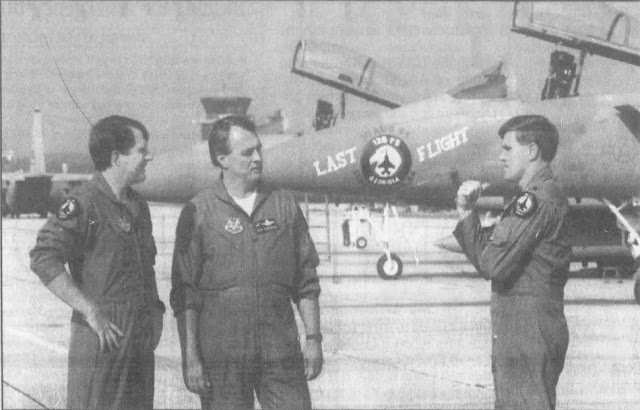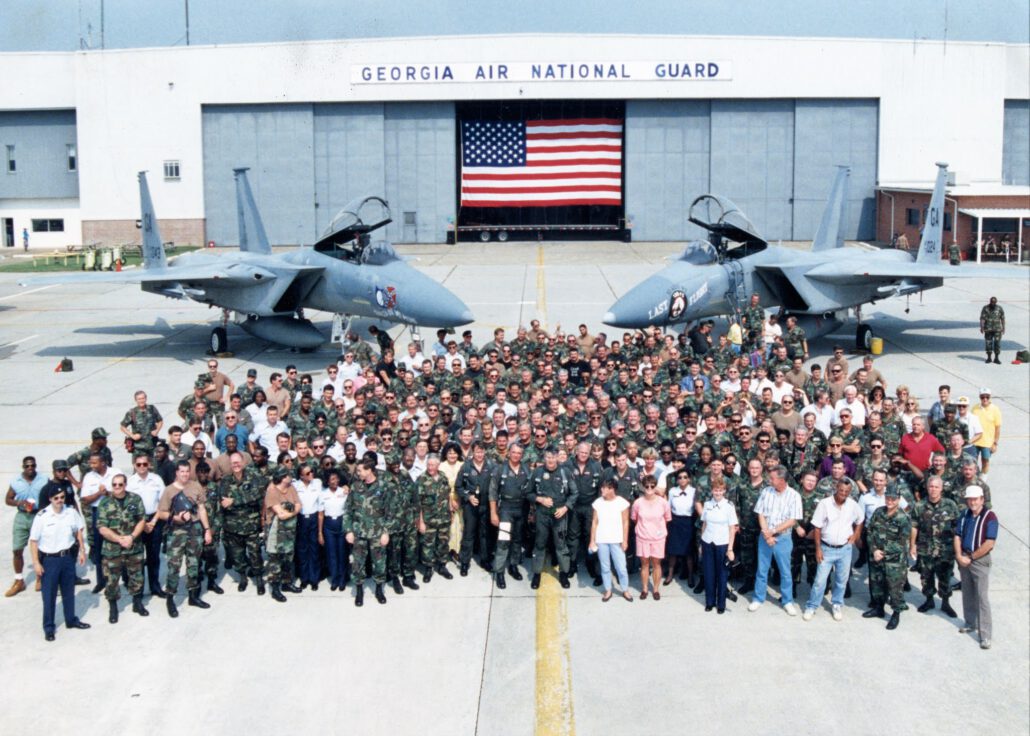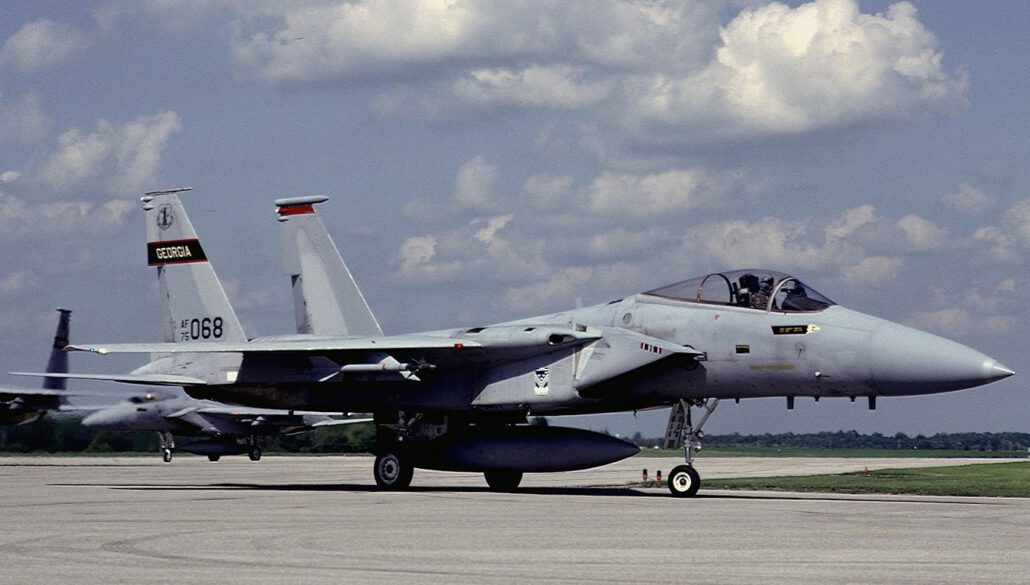Eagle History
Written by Col. Bob Doehling
May 1986 marked the beginning of the next significant period for the 116th Tactical Fighter Wing with the arrival of the first F-15A. This period would be filled with challenge, opportunity and turmoil as the Air National Guard and the unit became part of the “Total Force.” It would also be the longest time the 128th Tactical Fighter Squadron would remain in a single model of any aircraft – slightly over nine years. Part of this era included the 4-year operation of a single C-26 Operational Support Aircraft (OSA) to assist the unit meet the high level of travel required.

In 1986 the Eagle was the most capable air-to-air aircraft in the world. Its combat load-out was four semi-active radar “Sparrows,” four heat-seeking “Sidewinders,” and a twenty millimeter “Gattling” gun firing six-thousands rounds per minute. The aircraft combat gross weight of 37,500 pounds, 50,000 pounds total thrust and a nine-g turn capability allowed the aircraft to out perform any other air-to-air fighter in both the beyond visual range (BVR) and close-in “dogfight” arenas. It was designed to be the ultimate air-to-air airplane of the last three decades of the twentieth century.
Once again the 116th TFW underwent a significant change and along with it — turmoil. No longer was the mission air-to-ground. No longer were the airplanes crewed with both a Pilot and Weapons Systems Officer. The mission was still specialized but now it was fighting enemy aircraft and pilots rather than attacking ground targets or dueling with surface-to-air systems. The WSO was no longer needed and so many were forced to leave for other assignments or civilian jobs. Those who stayed moved to other career fields. There was turmoil as decade long members moved on to other opportunities.
Technology replacing the WSO was built into the Eagle to allow pilots to operate offensive and defensive systems by manipulating a myriad of switches and buttons installed on the throttles and control stick while watching attack parameters on the “HUD” and easily readable displays. Later in the life of the F-15A, the aircraft underwent the “Multi-Stage Improvement Program” (MSIP) that gave the added capability of the “Advanced Medium Range Air-to-Air Missile (AMRAAM) and the tactical “Situation” display. These two very significant improvements allowed “force multiplication” where a single flight of four F-15s had the capability equal to that of four flight of previous models. The AMRAAM allowed for long-range engagement of superior forces with “launch-and-leave” missiles.
The first milestone the unit passed in the Eagle was the Operational Readiness Inspection (ORI) of August 1988 at Savannah’s Travis Field Combat Readiness Training Center (CRTC). For three days, pilots flew, support personnel supported and maintenance turned more 50 air-to-air sorties per day. Surge capability was exercised with some aircraft flying as many as six sorties a day. When the smoke cleared, the unit was deemed “Mission Ready” by the 9th Air Force Inspector General (IG) once again.
The next two months following the ORI were used to prepare for the unit’s first attempt to win “William Tell”— the worldwide air-to-air gunnery competition held every other year at Tyndall Air Force Base in Florida. The unit would attempt to win this competition on two separate occasions. Preparing to win William Tell requires committing almost all the flying resources and ground crew training for at least three months prior to the one-week competition. The 128th TFS team performed very well in the William Tell 88 competition considering the team had less than six weeks to prepare. The second attempt the 128th made to win William Tell was in 1990. After three months of extensive preparation, the event was cancelled with the beginning of “Desert Shield” — the build-up of Allied Forces leading up to the Persian Gulf War “Desert Storm.” This was the last time the unit would pursue the winning of this prestigious event.
The unit participated in many deployments during the Eagle years. Countless deployments for “Flags” and other significant training were accomplished. The unit deployed at least a dozen times to the Savannah CRTC as well as the other three CTRTs to take advantage of superior air-to-air ranges and instrumentation systems used for tracking multiple aircraft during flight. The unit also pulled “Air Defense Alert” during several periods while other units converted or deployed. In addition, three highly memorable overseas deployments were conducted. The first was “Coronet Freedom” at Balikesir, Turkey in October 1991 where the unit lived in a “Tent City” for two weeks. Almost 600 members and 18 aircraft deployed to live in the mud. It was during the deployment to Turkey the unit came together creating what many unit participants would later remember as “the best deployment ever.” The second overseas deployment was to Howard Air Force Base, Panama Canal in support of “Sentry Night Hawk” (counter-drug operations). During around the clock alert operations, many valuable night flying lessons were learned using night vision goggles (NVG) for the first time. The final overseas deployment was to Singapore where the unit flew in support of “Commando Sling” — a Singapore Air Force exercise to enhance training of their defensive forces.
Significant recognition for tremendous effort and achievements were bestowed upon the unit during this period. Three more Air Force Outstanding Unit Awards (numbers seven, eight and nine) were awarded. Two 9th Air Force IG ORIs were rated “Excellent.” Three 9th Air Force Standardization Evaluation Inspections with one rated “Excellent” and two rated “Outstanding.” Two unit management inspections were also conducted with one rated “Excellent” and the last rated as “Best Seen” under the Total Quality Inspection program. The 116th Fighter Wing Maintenance Complex was rated as “Best in the World” during its final inspection.
Other significant events experienced during this period were; the changing of the unit from Tactical Air Command to Combat Air Command; the dropping of the designation of “Tactical” in both Fighter Wing and Fighter Squadron; and creation of the Operations, Logistics and Support Groups as the Air Force reorganized. In addition, Air National Guard reorganization and mission changes resulted in a decrease in unit aircraft assigned from 24 to 18 and finally 15. Eventually it was to mean a new mission entirely with the pending conversion to the B-1 announced in May 1993.
The final year of the F-15 operations was the most intense of all. Major deployments to Singapore and Nellis AFB combined with high sortie levels flown kept everyone focused on the mission at hand. Two major deployments and over 3500 sorties were flown in the most challenging scenarios the unit could partake.
The last F-15 mission was flown on 31 August 1995, a four-ship with two specially marked aircraft included. lead by Col Bob Doehling (#1) Col Bruce McLane (#3), Maj Rich Zatorski (#2) and Maj Tee Jordan (#4).
Two Eagles in the fourshop were specially marked Eagles, they were F-15A 75-0024, “Last Flight” with a likeness of the squadron insignia and the date, and 75-0043, “Georgia On My Mind” and an image of the Georgia state flag.
MARKINGS: Black band outlined in red with GEORGIA in yellow on the outer side of the vertitical tails. Flight colours blue, yellow, red and green as fin tip band on the inner side of the tails. F-15A 74-0116 was the 116th TFW Wing commander, and 74-0128 the 128th TFS squadron commander aircraft. Paticipated in the William Tell Meet in October 1988 with the four flight colours on the vertical rudders. From June 1989 only a gray outlinelow-vis broad band on the outer side of the fins and from spring Spring 1992 GA tail code, no other markings. Camouflage was the Compass Ghost and later the darker Mod Eagle scheme. Some aircraft noted painted gunship gray
Squadron photos


Georgia National Guard Archives.
